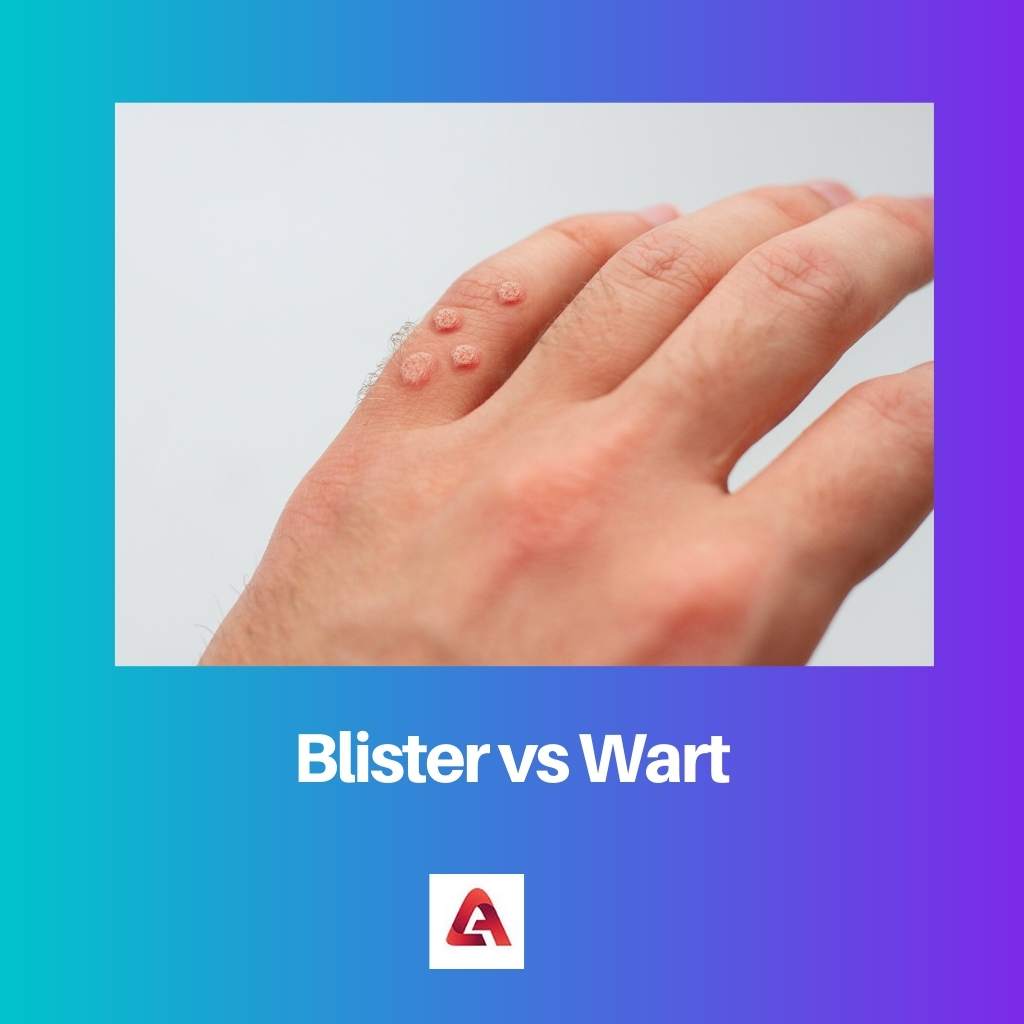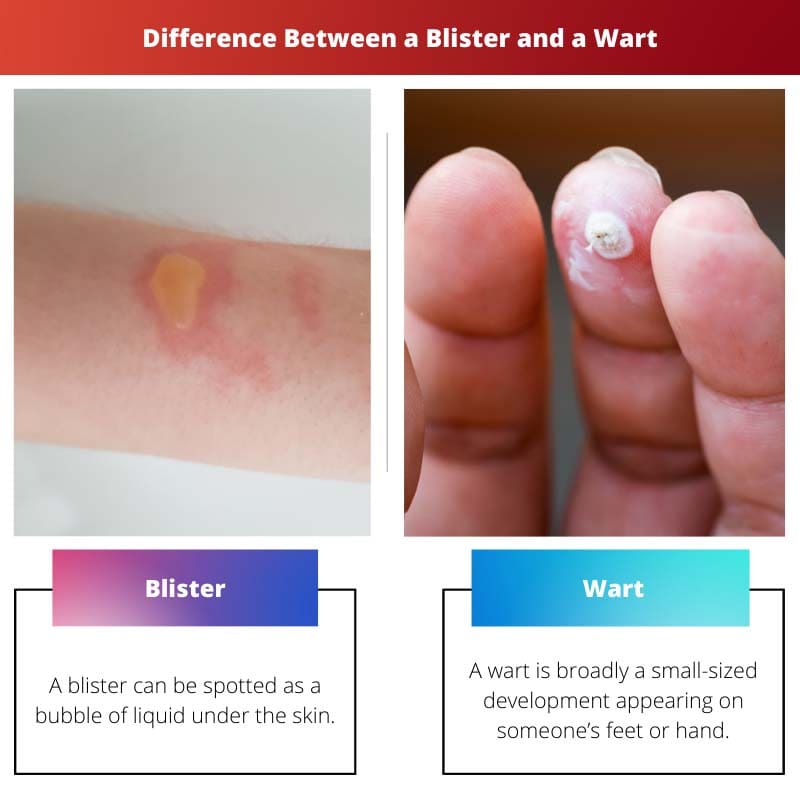If you possess a skin bump or growth on your body, you might think about whether it is a blister or a wart. Both may look alike in a number of ways but sometimes leads to some problems in recognition and diagnosis.
But despite the similarities, blisters and warts differ in several aspects.
Key Takeaways
- A blister is a small fluid-filled sac that develops on the skin, while a wart is a small, rough growth that appears on the hands and feet.
- Blisters are caused by friction or burns, while a viral skin infection causes warts.
- Blisters heal on their own within a few days, while warts may require treatment such as topical medication or removal by a healthcare professional.
Blister vs Wart
A blister is a small gap on the outer layer of the skin filled with fluid caused by rubbing a hard surface, heat, or any skin problem. Warts are small rough, and textured outgrowths on the skin, occurring on hands and feet due to a viral infection. Warts are non-cancerous skin-colored elevations.

Blisters always influence the superficial layers of skin and protrude in particular places like hands, feet, face, etc. Fluid accumulation occurs between the upper and lower skin layers to enhance healing and give cushioning effect.
Blisters occur reluctantly to people who involve themselves in ill-wearing of stuff.
On the other hand, warts are hard rough growth that doesn’t result in many symptoms except when located on the bottom side of the feet. Though they protrude on feet and hands, they can also be seen in other body parts.
They are not cancerous, and one or many warts can appear at a time.
Comparison Table
| Parameters of Comparison | Blister | Wart |
|---|---|---|
| Cause of occurrence | Allergies, irritation, etc. | Human papillomavirus (HMV) |
| Color | May or may not match skin color | Have the color of the skin |
| Recognition symptoms | Painful and annoying | Non-painful and itchy |
| Fall-off time | After 4-7 days | Approximately two years or maybe more |
| Nature | Infectious | Non-infectious |
What is a Blister?
A blister can be spotted as a bubble of liquid under the skin. This fluid is watery and clear and is known as serum. It exudes from bordering tissues, a response to wounded skin.
If a blister stays unopened, serum can give a natural defence for the skin below it.
The small ones are known as vesicles, while those bigger than half an inch are known as bullae. If a blister is with blood instead of serum is known as a blood blister. There could be many reasons for a blister, but the two main ones are allergies and irritation.
Allergic contact dermatitis, which is a form of eczema, may result in forming a blister. Blisters may occur because of physical agents that peeve the skin, like skin rubbing, irritating chemicals, or maximal heat or cold.
On the feet, maybe because of tight shoes or skin rub in the area. With that, any sort of smouldering, like sunburn, can also lead to blisters.
If the reason for the blister isn’t evident, you must seek a doctor. To diagnose, he could ask you for your medical history regarding allergies and irritations or previous medications. Then treatment or medicines will be given accordingly.

What is a Wart?
A wart is broadly a small-sized development appearing on someone’s feet or hand. It looks like a small cauliflower or solid blister. They aren’t smooth and have a rough appearance.
It is principally because of Human papillomaviruses (HPV). HPV causes keratin to expand too fast, making a layer on top of the skin. There are five types of warts that a person can possess:
- Common Warts: They are seen on your toes and fingers and in other places. They are grainy, rough, and round from the top in appearance. Color-wise, they appear greyish to the surrounding skin.
- Plantar Warts: These grow on feet soles and stay on your skin. These can lead to uncomfortable walking.
- Flat Warts: These can be seen on thighs, arms, or face. With being small in size, they are flat from the top.
- Filiform Warts: These protrude around the nose, mouth, neck, or under the chin. With being small and flappy in appearance, these have the color of your skin.
- Periungual Warts: It grows around and under fingernails and toenails. These might affect the growth of nails and might pain a bit.
Warts can become hard to eliminate completely. Experts say that many a time, more than a single treatment is required for better warts management.

Main Differences Between a Blister and a Wart
- A blister is a tiny patch of body liquid caused by rubbing, freezing, or chemical exposure. On the other hand, a wart is grainy, small growth that is a viral infection in nature.
- Mostly a blister has clear fluid-filled in it like plasma, serum, or pus. Whereas a wart is composed of toughened, enlarged cells of the skin.
- Blisters heal on their own and could be prevented beforehand. However, warts can only be treated via local applications, oral medications, and surgical procedures.
- Blisters pain a lot if in the deeper coverage of the skin. On the other hand, warts are painless in nature.
- Blisters occur in specific areas like on the face area or on the toes area, while warts can occur anywhere in your body.

- http://www.koreamed.org/SearchBasic.php?RID=2086713
- https://jamanetwork.com/journals/jamadermatology/article-abstract/526040